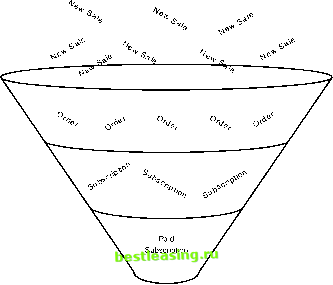

 |
 |

|
Промышленный лизинг
Методички
include taking blood samples before setting rates. In general, activation is an operational process, more focused on business needs than analytic needs. As an operational process, customer activation may seem to have little to do with data mining. There are two very important interactions, though. The first is that activation provides a view of new customers at the point when they join. This is a very important perspective on the customer, and, as a data source, it needs to be preserved. Both the initial conditions and subsequent changes are of interest. TIP Customer activation provides the initial conditions of the customer relationship. Such initial conditions are often useful predictors of long term customer behavior. Activation is also important because it narrows it further refines the customer base. This is a funneling effect, as shown in Figure 14.8. This process is for a newspaper subscription, a familiar process analogous to many similar processes. It basically has the following steps: The Sale. A prospect shows interest in getting a subscription, by providing address and payment information, either on the Web, on a call, or on a mail-in response card. The Order. An account is created, which includes a preliminary verification on the address and payment information. The Subscription. The paper is actually physically delivered, requiring further verification of the address and special delivery instructions. The Paid Subscription. The customer pays for the paper.  Week Number Figure 14.7 Correlation between two channels over time suggests that one channel may be leaking into another or something external is affecting both channels. New sales come in through many channels. Only sales with verifiable addresses and credit cards become orders. Only orders with routable addresses become subscriptions. Only some subscriptions are paid.  Figure 14.8 The customer activation process funnel eliminates responders at each step of the activation process. Each of these steps loses some customers, perhaps only a few percent perhaps more. For instance, credit cards may be invalid, have improper expiration dates, or not match the delivery address. The customer may live outside the delivery region. The deliverers may not understand special delivery instructions. The address may be in an apartment building that does not allow access, or the customer may simply not pay. Most of these are operational considerations (the exception is whether or not the customer pays), and they illustrate the kinds of operational concerns and processes involved with customer activation. Data mining can play a role in understanding when customers are not moving through the process the way they should be-or what characteristics cause a customer to fail during the activation stage. These results are best used to improve the operational processes. They can also provide guidance during acquisition, by highlighting strategies that are bringing in sales that are not converted to paid subscriptions. For Web-related businesses, customer activation is usually, although not always, an automatic process that takes little time. When it works well, there is no problem. Although it can take a short amount of time, it is a critical part of the customer acquisition process. When it fails, potentially valuable customers are kept away. Relationship Management Once a prospect has become a customer, the goal is to increase the customers value. This usually entails the following activities: Up-Selling. Having the customer buy premium products and services. Cross-Selling. Broadening the customer relationship, such as having customers buy CDs, plane tickets, and cars, in addition to books. Usage Stimulation. Ensuring that the customer comes back for more, for example, by ensuring that customers see more ads or uses their credit card for more purchases. These three activities are very amenable to data mining, particularly predictive modeling that can determine which customers are the best targets for which messages. This type of predictive modeling often determines the course of action for customers, as discussed in Chapter 3. However, there is a challenge of providing customers the right marketing messages, without inundating them with too many or contradictory messages. Although telephone calls and mail solicitations are bothersome, unwanted email messages (often called spam) tend to have a more negative effect on the customer relationship. One reason may be that customers are often paying for their Internet connection or for the disk space for email. Another reason may be that this mail may arrive at work, rather than at home. Then there is the problem of spam that includes annoying pop-up ads. And, of course, such email has often been quite unsolicited, offending people who do not want to receive solicitations for gambling, money laundering, Viagra, sex sites, debt reduction, illegal pyramid marketing schemes, and the like. Because email is abused so often, even legitimate companies who are communicating with bona fide customers run the risk of being associated with the dubious ones. This is a danger, and in fact suggests that customer contact needs to be broader than email. Another danger for companies that offer many products and services is getting the right message across. Customers do not necessarily want choice; customers simply want you to provide what they want. Making customers find the one thing that interests them in a barrage of marketing communication does not do a good job of getting the message across. For this reason, it is useful to focus messages to each customer on a small number of products that are likely to interest that customer. Of course, each customer has a different potential set. Data mining plays a key role here in finding these associations. Retention Customer retention is one of the areas where predictive modeling is applied most often. There are two approaches for looking at customer retention. The first is the survival analysis approach described in Chapter 12, which attempts to understand customer tenure. Survival analysis assigns a probability that a customer is going to leave after some period of time. 1 2 3 4 5 6 7 8 9 10 11 12 13 14 15 16 17 18 19 20 21 22 23 24 25 26 27 28 29 30 31 32 33 34 35 36 37 38 39 40 41 42 43 44 45 46 47 48 49 50 51 52 53 54 55 56 57 58 59 60 61 62 63 64 65 66 67 68 69 70 71 72 73 74 75 76 77 78 79 80 81 82 83 84 85 86 87 88 89 90 91 92 93 94 95 96 97 98 99 100 101 102 103 104 105 106 107 108 109 110 111 112 113 114 115 116 117 118 119 120 121 122 123 124 125 126 127 128 129 130 131 132 133 134 135 136 137 138 139 140 141 142 143 144 145 146 147 148 149 150 151 152 153 154 155 156 157 158 159 160 161 162 [ 163 ] 164 165 166 167 168 169 170 171 172 173 174 175 176 177 178 179 180 181 182 183 184 185 186 187 188 189 190 191 192 193 194 195 196 197 198 199 200 201 202 203 204 205 206 207 208 209 210 211 212 213 214 215 216 217 218 219 220 221 222 |